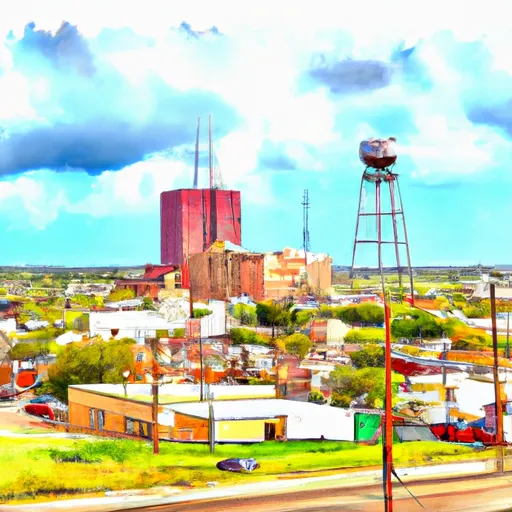-
 Snoflo Premium
Snoflo Premium
Get unlimited access to all our content
With no Ad interruptions! - Start Your Free Trial Login with existing account
Trinidad
Eden Index
Climate
9.7
•
Recreation
4.5
•
Community
0.6
•
Safeguard
5.6/10

Trinidad, Texas is a small town located in Henderson County. It experiences a humid subtropical climate with hot summers and mild winters. The average high temperature in summer is around 93°F (34°C), while in winter, it drops to about 58°F (14°C). The area receives an average annual rainfall of 40 inches, with May being the wettest month.
Trinidad sits on the shores of the Cedar Creek Reservoir, providing ample hydrological opportunities. The reservoir is known for its excellent fishing, particularly for largemouth bass, crappie, and catfish. Water sports such as boating, jet skiing, and swimming are also popular activities in the area.
Outdoor enthusiasts can explore the nearby Trinidad State Fish Hatchery, which offers educational programs and fishing opportunities. The Purtis Creek State Park is another outdoor haven, offering camping, hiking, and bird-watching opportunities. With its diverse flora and fauna, the park is a great destination for nature lovers.
Overall, Trinidad, Texas offers a pleasant climate, diverse hydrology constituents, and a range of outdoor recreational opportunities for residents and visitors to enjoy.
What is the Eden Index?
The Snoflo Eden Index serves as a comprehensive rating system for regions, evaluating their desirability through a holistic assessment of climate health, outdoor recreation opportunities, and natural disaster risk, acknowledging the profound impact of these factors on livability and well-being.
Climate Health Indicator (CHI): 9.7
Trinidad receives approximately
1035mm of rain per year,
with humidity levels near 79%
and air temperatures averaging around
19°C.
Trinidad has a plant hardyness factor of
8, meaning
plants and agriculture in this region tend to thrive here all year round.
By considering the ideal temperature range, reliable water supplies, clean air, and stable seasonal rain or snowpacks, the Climate Health Indicator (CHI) underscores the significance of a healthy climate as the foundation for quality living.
A healthy climate is paramount for ensuring a high quality of life and livability in a region, fostering both physical well-being and environmental harmony. This can be characterized by ideal temperatures, reliable access to water supplies, clean air, and consistent seasonal rain or snowpacks.
Weather Forecast
Streamflow Conditions
Upper Trinity
Area Rivers
Upper Trinity
Snowpack Depths
Upper Trinity
Reservoir Storage Capacity
Upper Trinity
Groundwater Levels
Recreational Opportunity Index (ROI): 4.5
The Recreational Opportunity Index (ROI) recognizes the value of outdoor recreational options, such as parks, hiking trails, camping sites, and fishing spots, while acknowledging that climate plays a pivotal role in ensuring the comfort and consistency of these experiences.
Access to outdoor recreational opportunities, encompassing activities such as parks, hiking, camping, and fishing, is crucial for overall well-being, and the climate plays a pivotal role in enabling and enhancing these experiences, ensuring that individuals can engage in nature-based activities comfortably and consistently.
Camping Areas
| Campground | Campsites | Reservations | Toilets | Showers | Elevation |
|---|---|---|---|---|---|
| Public Use Area 5 - Thornton | None | 369 ft | |||
| Lake Tawakoni State Park | 78 | 457 ft | |||
| Navasota RV Park | 10 | 221 ft | |||
| Fairfield Lake State Park | 135 | 382 ft | |||
| Bonham State Park | 21 | 613 ft | |||
| Purtis Creek State Park | 78 | 424 ft | |||
| Gibbons Creek Reservoir | 27 | 255 ft | |||
| Wind Point Park | 135 | 457 ft |
Catastrophe Safeguard Index (CSI):
The Catastrophe Safeguard Index (CSI) recognizes that natural disaster risk, encompassing floods, fires, hurricanes, and tornadoes, can drastically affect safety and the overall appeal of an area.
The level of natural disaster risk in a region significantly affects safety and the overall livability, with climate change amplifying these risks by potentially increasing the frequency and intensity of events like floods, fires, hurricanes, and tornadoes, thereby posing substantial challenges to community resilience and well-being.
Community Resilience Indicator (CRI): 0.6
The Community Resilience Indicator (CRI) recognizes that education, healthcare, and socioeconomics are crucial to the well-being of a region. The CRI acknowledges the profound impact of these elements on residents' overall quality of life. By evaluating educational resources, healthcare accessibility, and economic inclusivity, the index captures the essential aspects that contribute to a thriving community, fostering resident satisfaction, equity, and social cohesion.

